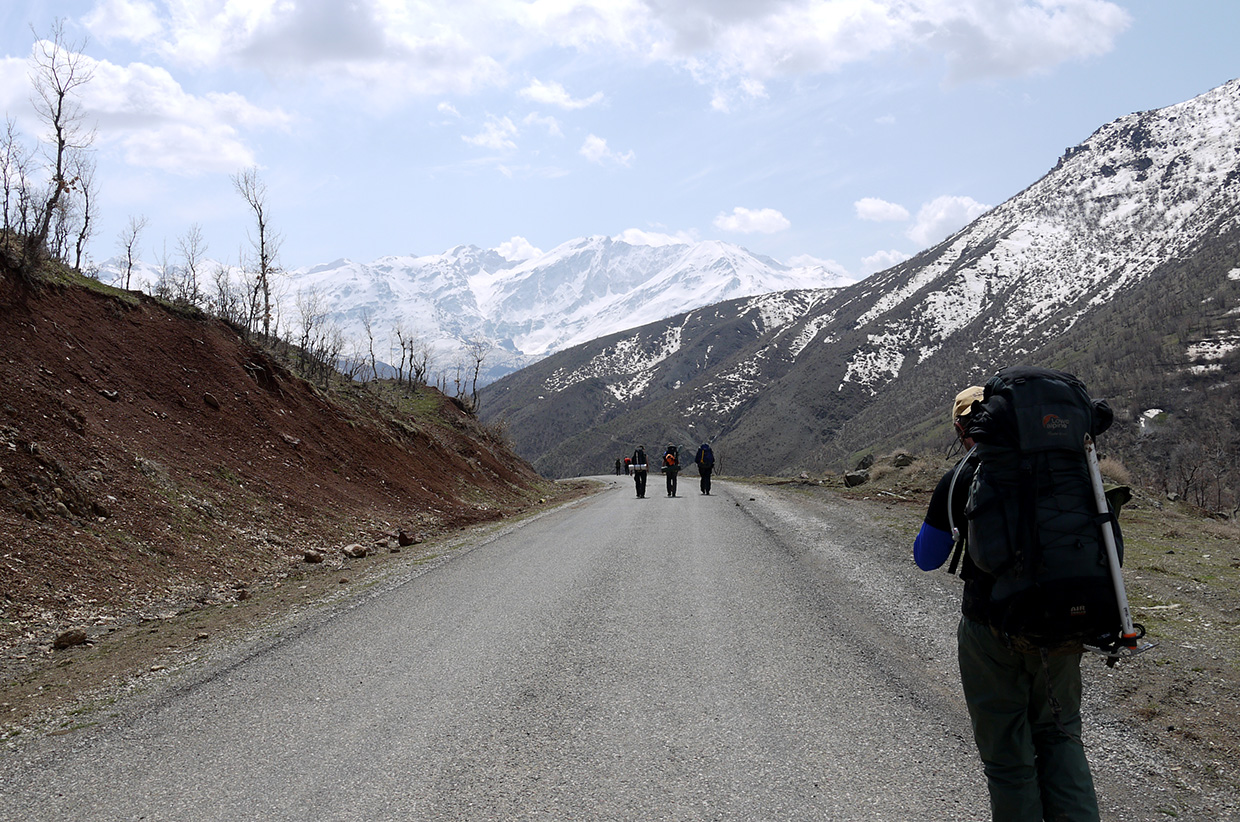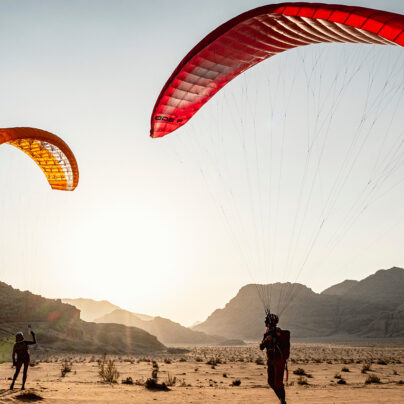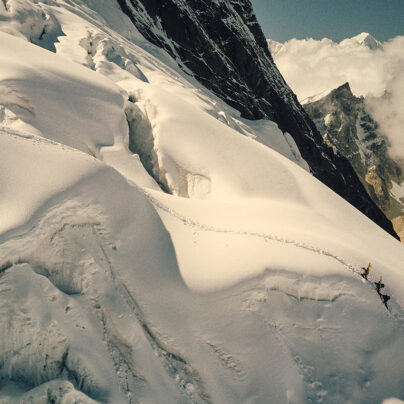Climbing In Iraq
Tom Evans
An expedition to climb in the mountains of Iraq is a rare opportunity and one that I figured would not come around too often. It was the Easter before my University finals but I certainly knew which to put first. Attempting Iraq’s highest peak, Cheekah Dar in the Zagros mountains of Kurdistan, certainly had priority over my degree at Newcastle University – it was only 10 days without revision! The expedition was run by Secret Compass, an expedition provider I had been working for part time during university and I had the opportunity to tag along. Our proposed target,Cheekah Dar, has only ever been climbed twice before; once in summer and for the first time in Winter just last year.
Landing in the city of Erbil, a settlement dating back to 6,000BC in the country’s North, was surreal. From the extremely heavily fortified airport to the modern town built around the ancient dilapidated settlement, everything was a bit chaotic. Shops sell army surplus rather than souvenirs and the few westerners around are there for the oil industry or working for NGOs, they aren’t tourists! We planned to head to the mountain town of Choman and then up towards Cheekah Dar but things didn’t exactly go to plan, as you might expect in such a country.
Having left Erbil and spent a night in the mountains above Choman we were contacted by the local police and called to meet them. This rather inconvenient and unwanted meeting led to a further meeting several hours drive away with the family who controlled the area – all we really wanted to do was head in to the mountains, we weren’t particularly happy. Negotiations were carried out at a hill top mansion surrounded by security and high fences, the owners of which drove two brand new Range Rovers – it was more like Cheshire than Iraq and certainly seemed fairly dodgy! We were told that we would have to climb Mt. Halgurd, Iraq’s second highest peak. Cheekah Dar lies on the border with Iran, we were informed that it’s patrolled by the Iranians and in an area regularly bombed by the Turkish Airforce – both a little hard to believe. Despite our frustrations we had to abide by their rules and were soon on our way back to the mountains.
What we hadn’t realised was that we’d spend that night in the local police station rather than in our tents; a safety measure we were told, but just an inconvenience to us. Despite restrictions on our movements the locals were incredibly friendly, inviting us to their houses and entertaining us with both music and a show and tell involving an array of guns! The majority of the Kurdish people we encountered were incredibly pleased to see visitors, and are keen to increase tourism in the area, reinforcing the fact that Kurdistan is a fairly autonomous and much safer region of Iraq.
The majority of the Kurdish people we encountered were incredibly pleased to see visitors, and are keen to increase tourism in the area, reinforcing the fact that Kurdistan is a fairly autonomous and much safer region of Iraq.

Suddenly, out of nowhere, the person at the front of our snaking line of climbers fell. A small cliff had appeared out of nowhere through the white and only a skilful ice axe arrest had prevented them sliding hundreds of metres.
Towards the end of the day the weather closed in. Whiteout conditions replaced clear blue skies and, worst of all, it started snowing again. Suddenly, out of nowhere, the person at the front of our snaking line of climbers fell. A small cliff had appeared out of nowhere through the white and only a skilful ice axe arrest had prevented them sliding hundreds of metres. This was a shock for all of us, it highlighted the dangers we were facing and forced us to set up camp near by. Wind speeds were incredibly high, making erecting the tents extremely difficult, and little did we know that we’d spend over 16 hours under canvas as we struggled to put our shelters up. It was a terrible night in our rattling, collapsing, coffin-like tents and one of the worst many of us had ever experienced.
The morning couldn’t come soon enough and the bright sunshine was certainly a welcome sight, even if wind speeds were still high. We dismantled our camp, packed up, strapped our crampons on and grabbed our ice axes to set off further towards Halgurd. We were currently at around 3,000 metres – from here the terrain grew steeper and progress would be slower. The altitude also started to take affect as we worked ever higher, breathing became heavier as we required more effort to climb. Unfortunately, as is often the case in the mountains, the beautiful sunny conditions were, as with the previous day, replaced with cloud. Piercing bullets of icy snow began to be blown horizontally in to our faces, one of the winter months less pleasant offerings that only made the day tougher. The weather didn’t look promising if we were hoping to push up to the summit the next day. We also knew that we were forging a route up a mountain that has never been summited in winter. It was new territory for us all.
Reaching around 3,500 metres in the early afternoon we all took a deserved rest, taking on food and water, before discussing our progress and plans. The weather was now appalling,progress was slow and we found out that conditions were set to stay poor for the rest of the afternoon and following day. This wasn’t ideal; we could wait for two days for a possible window in the weather to push up the last, most difficult, bit of the climb or retreat to the safety of the lower valley. The team was divided; all of us wanted to summit Halgurd but most knew that realistically the conditions were unsafe and unlikely to allow a summit bid. Being a commercial expedition the safety of the team has to come first, before achieving the aim. Despite disappointing much of the team the decision was made to retreat back down the mountain; the snow made going tough, the wind and whiteout made it dangerous – there was no guarantee of a summit or the safety of the whole team. As with any expedition or adventure, the safety of those taking part is paramount; summit fever cannot be allowed to take the place of common sense. Personally I was disappointed yet glad to choose safety over recklessness. Mountains aren’t going anywhere, I’ll be back.

The rest of the afternoon was spent descending, much to the discomfort of our knees. This allowed Kit, our Norwegian team member, to strap on his skis and enjoy a much quicker descent. Having lugged his skis all the way up to 3,500 metres he certainly deserved the rest, and the honour of becoming the first person to ski in Iraq! We wearily made our way down to an abandoned building to regroup and shelter from the now driving storm. As this was to be our home for the night we made every effort to clear it out before firing up the stoves for much needed tea and coffee. The storm raged all night, the wind howling and the snow being driven in to our shelter. We couldn’t complain, we weren’t stuck in our tents for 16 hours again and, fingers crossed, these walls couldn’t collapse.
The poor weather the following morning made way for a brief period of sunshine and clear skies. Peeling away our sleeping bags and braving the outdoors we made our way out of the shelter and up a nearby peak. To our knowledge this small peak may never have been climbed, it definitely wouldn’t have been in winter. Reaching the summit was some consolation for the disappointment the team had experienced when turning back from the summit of Mt. Halgurd and lifted the spirits. It also provided a fantastic opportunity to enjoy the views of the mountains we were in; we’d spent much of the time merely looking at the blanket of bright white blend of snow and sky and the person in front of us. Our lack of luck continued as we reached our shelter once more; the weather closed in again and for the second night running we were confined to the claustrophobic little building, telling terrible jokes and ‘enjoying’ the freeze dried rations.
The following day, with the weather remaining poor, it was decided that we’d head out of the mountains. The conditions were terrible and there was little point staying put with nothing to achieve. While the little time we had in the mountains may have appeared a failure it was a fantastic experience for all, and an important learning curve – many expeditions do infact fail. If all expeditions were to succeed the world would be a very boring place, without challenge and without genuine adventure. Climbing in Iraq was a genuine adventure; from the fantastic hospitality of some to the restrictions made by others, the untouched mountains to the war weary towns and people, the country has a lot to offer.
While the little time we had in the mountains may have appeared a failure it was a fantastic experience for all, and an important learning curve – many expeditions do inFact fail. If all expeditions were to succeed the world would be a very boring place, without challenge and without genuine adventure.

Tom Evans is a keen climber, cyclist, skier and lover of adventure, the outdoors and sport, including cricket and rugby. He graduated this July (2012) with a BSc in Geography from Newcastle University.
You can find out more on Facebook, Twitter @exceedpossible or via his website www.exceedpossibility.co.uk





